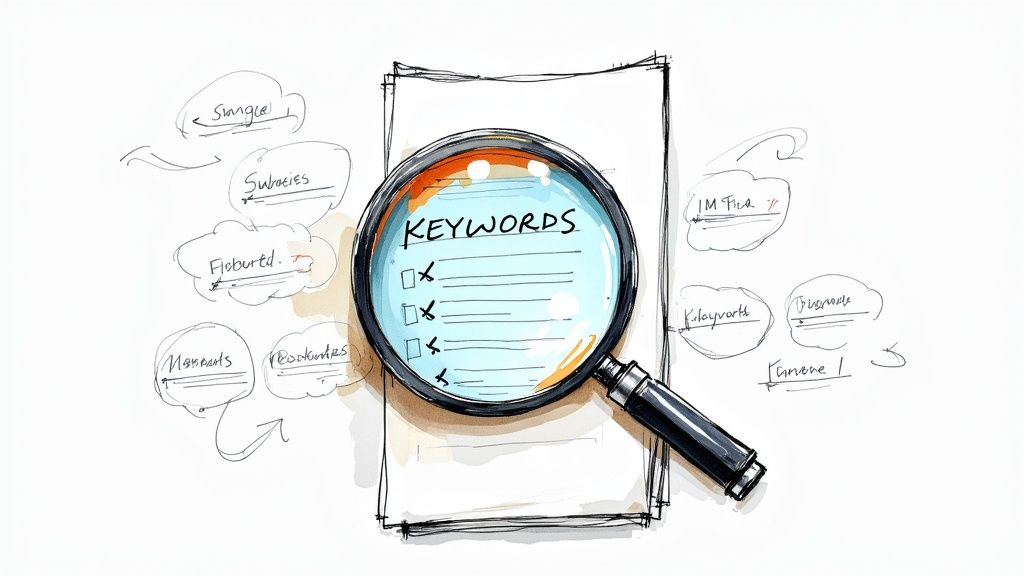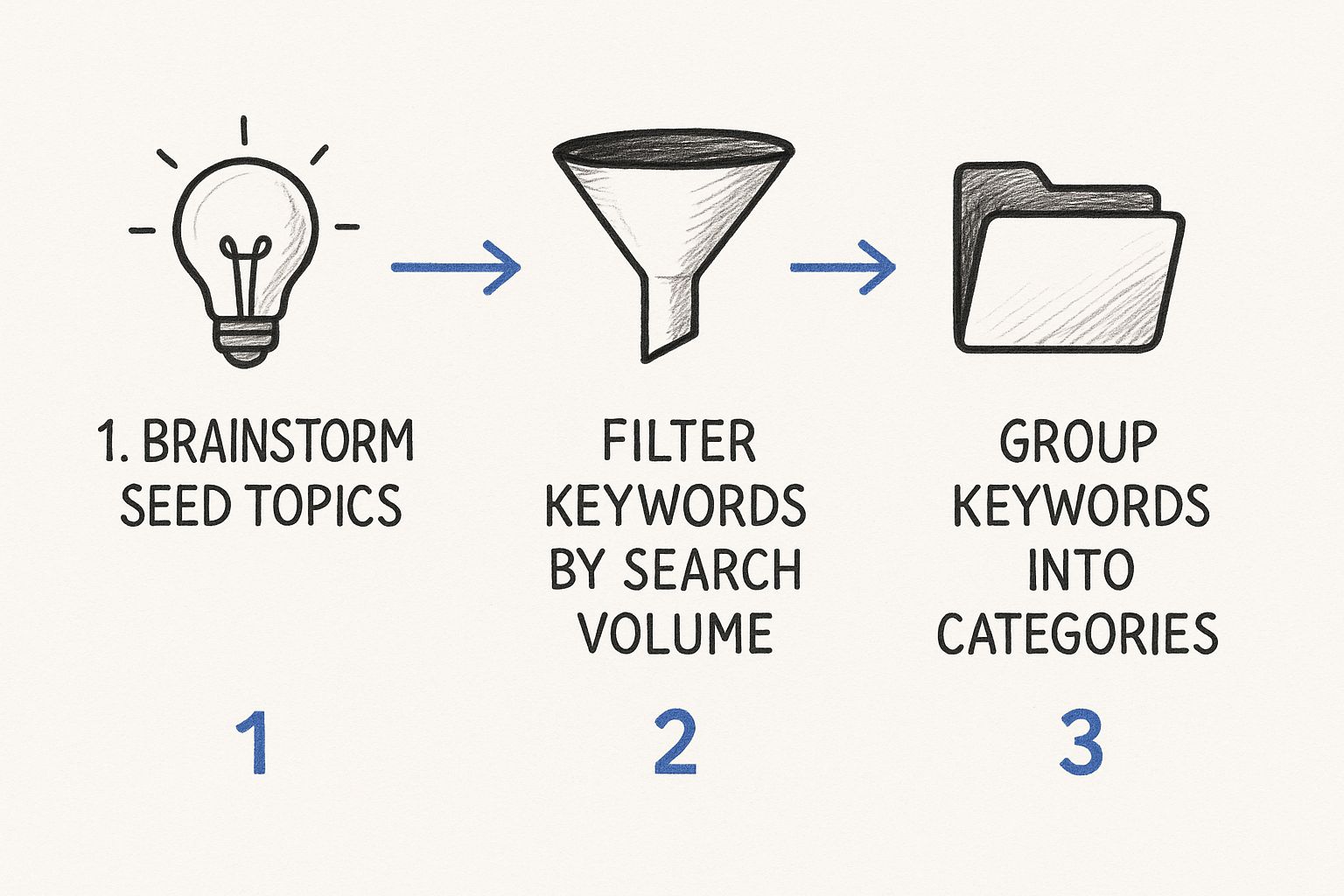When you're building a keyword list for Google Ads, you're essentially creating the blueprint for attracting visitors who are ready to buy. The process starts with understanding your customer's problems, brainstorming a core set of "seed" keywords, and then using tools like Google Keyword Planner to flesh out that list. From there, it's all about refining with match types and negative keywords to sharpen your focus.
Why a Smart Keyword List Is Your Campaign's Backbone
Think of your Google Ads campaign like a finely tuned engine. Your budget isn't the fuel—your keyword list is. A weak list pulls in the wrong crowd, which means wasted ad spend and results that are, frankly, depressing. This isn't about traditional SEO; it's about zeroing in on commercial intent.
The right keywords build a bridge, connecting someone's urgent Google search directly to your solution. To really get this, it helps to understand What Does SEM Mean?, since Google Ads is a huge piece of that puzzle. Getting your keywords right has a direct impact on the metrics that matter most:
- Quality Score: When your keywords align perfectly with your ads and landing pages, Google rewards you with better ad positions and lower costs. It's their way of saying, "You're giving users what they want."
- Ad Relevance: Tightly themed keywords mean your ads speak directly to the searcher’s problem. This naturally leads to higher click-through rates because you're showing up as the obvious answer.
- Cost-Per-Acquisition (CPA): By targeting people who are showing strong signals that they're ready to buy, you boost your conversion rates and drive down how much it costs to land a new customer.
Your keyword list is more than just a bunch of terms; it’s a strategic filter. Its job is to pull in your ideal customer at the exact moment they need you and—just as crucial—to push away everyone else.
Getting this part right is absolutely fundamental, especially if your goal is generating high-quality leads. For a much deeper look into how this all connects, check out our complete guide on mastering Google Ads for lead generation. You’ll see just how much a solid keyword foundation can make or break your entire campaign.
Finding Seed Keywords Your Customers Actually Use

Before you ever open a keyword research tool, the most important work happens away from the screen. Great keyword lists are built on real human language, not the industry jargon we think people use. The goal here is to figure out how your customers actually talk about their problems and needs.
This is where we find our seed keywords. These are the foundational, 1-3 word phrases that describe the core of what you offer. Think of them as the starting point for everything else. For a plumber, a great seed keyword isn't "compression valve failure"; it's the much more common "leaky faucet."
Tap into Your Company’s Hidden Data
Your business is already sitting on a goldmine of customer language. You just need to know where to dig. Instead of guessing what people might be searching for, why not look at what they’re already telling you?
This internal data gives you an authentic, unfiltered look into the mind of your customer. Here are a few of my go-to sources:
- Customer Service Transcripts: Dive into your chat logs and support emails. What specific words do people use over and over again when they describe their frustrations? Those are your keywords.
- Sales Team Call Notes: Your sales team is on the front lines every day. They hear every question, every objection, and every goal straight from the mouths of potential customers. Their notes can uncover high-intent keywords you'd never think of on your own.
- Online Forums (like Reddit): Find subreddits related to your industry and just listen. People post threads asking for help, recommendations, or just to complain about a problem your business solves. The language in those post titles and comments is pure, conversational gold.
Grounding your research in these real-world sources ensures your entire campaign is built around your customer, not just on what you think they're searching for.
Try to put yourself in their shoes. What was life like "before" they found a solution, and what is it like "after"? Keywords like "how to fix [the problem]" or "[problem] solution" are often fantastic starting points that catch people right at the beginning of their journey. Getting this part right is what separates a profitable campaign from one that just burns through your budget.
Tap Into Google's Own Tools to Grow Your Keyword List

Once you've got your core list of "seed" keywords based on what you know about your customers, it's time to find out what you don't know. And the best place to get that information is straight from the source: Google itself.
Your first stop should be the Google Keyword Planner, which you can find right inside your Google Ads account. This is the classic, go-to tool for a reason. Pop in your seed keywords, and it will spit back hundreds of related terms, giving you a massive pool of new ideas to work with.
But don't just grab every suggestion. The real skill is in understanding the data that comes with them.
Reading Between the Lines of Keyword Planner Data
The metrics you see next to each keyword are your roadmap for building a smart campaign. This isn't just about collecting more words; it's about picking the right battles—ones that align with your goals and, crucially, your budget.
Here’s what you need to focus on:
- Average monthly searches: This shows you the potential audience size for a keyword. A common mistake is chasing the highest numbers. Often, lower-volume terms with clear intent are where the real conversions happen.
- Competition: Shown as Low, Medium, or High, this tells you how many other advertisers are bidding on the same term. High competition usually means you'll have to pay more for each click.
- Top of page bid (low and high range): These numbers are Google's best guess for what you'll need to bid to get a top ad spot. Think of them as a ballpark estimate for your cost-per-click (CPC) to help you budget realistically.
This data is so powerful because of the sheer volume behind it. In 2025, Google is projected to process a mind-boggling 16.4 billion searches every single day. That's a huge jump from the 7 billion daily searches in 2020. With that much activity, having a data-backed plan is the only way to effectively reach the right people. You can dig into more of these fascinating SEO stats to get a better feel for the market.
A quick heads-up: those bid estimates are just that—estimates. They're based on historical data. Your actual CPC will swing based on your ad quality, landing page, and overall strategy.
Finding Hidden Gems Right on the Results Page
The Keyword Planner is powerful, but it's not the only tool Google gives you. The search engine results page (SERP) itself is an incredible resource for finding long-tail keywords—those longer, more specific phrases people use when they're getting serious about buying.
Just head to Google and search for one of your main keywords. Now, put on your detective hat and scroll down the page, keeping an eye out for two key areas:
- People also ask: This little box is pure gold. It shows you the literal questions your customers are typing into Google. A term like "best project management software for small teams" is infinitely more valuable than just "project management software" because the intent is so much clearer.
- Related searches: Look for this section at the very bottom of the page. It's where Google suggests other searches that are closely related to yours. This is a great way to find different angles or related niches you hadn't even considered.
When you blend the hard data from Keyword Planner with the real-world context you find on the SERP, your simple list of ideas transforms into a strategic foundation for a killer campaign.
Uncovering Competitor Keywords and Market Gaps

While Google's own tools are great, one of the smartest shortcuts is to peek at what your competition is already doing. Think about it: they are spending their own money right now to figure out which keywords convert in your market. Why not learn from their investment?
This isn’t about blindly copying their strategy. It’s about smart reconnaissance. You're looking for the battle-tested keywords they consistently pour money into. If they're bidding on a term day after day, that's a huge signal it’s probably making them money. This is how you fast-track your own path to a profitable keyword list.
Analyzing Your Competitors' Paid Ads Data
This is where third-party tools become your secret weapon. Platforms like Semrush and Ahrefs are fantastic for this kind of work. You just pop in a competitor's web address, and you get an inside look at their paid search playbook. It's like reverse-engineering their success.
When you're digging through their data, keep an eye out for a few key things:
- Their Biggest Bets: What are their top paid keywords? The terms they spend the most on are almost always their workhorses—the ones driving real leads and sales.
- Ad Copy Clues: Look at the language in their ads. What problems are they solving? What benefits are they highlighting? This tells you exactly what messaging is connecting with your target audience.
- The Gaps: Where are the opportunities they've missed? Maybe you're ranking for terms they aren't even touching. Finding these keyword gaps allows you to carve out your own space with less direct competition.
This kind of analysis shows you which keywords have proven market demand, so you can prioritize your own budget more effectively.
Let your competitor's ad spend become your research budget. When you see they've been bidding on the same keywords for months, you can bet those are high-intent terms worth adding to your own campaigns. It takes the guesswork out of the equation.
This data-driven approach is at the heart of modern keyword research. By understanding what your competitors are doing, you can spot the angles they've overlooked and give your own campaigns a serious edge. You can read more on modern keyword research strategies to see how this fits into a bigger picture.
Structuring Keywords Into Themed Ad Groups
Alright, you've done the hard work and built a massive keyword list. Now what? Just dumping it all into one campaign is a surefire way to burn through your budget with very little to show for it.
The secret to a high-performing Google Ads account isn't just what keywords you target, but how you organize them. We're talking about building tightly themed ad groups.
This is where the magic happens. You take that big, messy list and start creating small, focused buckets of keywords that are all incredibly similar to each other.

Think of it this way: every keyword in an ad group should be so closely related that the exact same ad copy and landing page feel perfectly relevant to someone searching for any of them. It's the same logic behind segmenting your marketing lists for email campaigns—the more targeted your message, the better the results.
The Power of Grouping by Intent
Let's imagine you run an online store that sells running shoes. You wouldn't want someone searching for "men's trail running shoes" to see the same ad as someone searching for "women's discount running shoes." They're completely different shoppers with different needs.
This is where grouping by intent and theme comes in. You can create ad groups for different brands, shoe types, user needs, and even competitor terms.
Here’s a table showing how you could structure your ad groups for a running shoe store. Notice how each group has a clear theme, which allows you to write incredibly specific ad copy.
Example Ad Group Structure for a Running Shoe Store
| Ad Group Theme | Example Keywords | Ad Copy Angle |
|---|---|---|
| Men's Trail Running | "men's trail running shoes", "off-road running shoes for men", "hoka speedgoat 5 men's" | Focus on durability, grip, and all-weather performance. Mention specific trail-friendly features. |
| Women's Road Running | "women's road running sneakers", "best running shoes for pavement women", "brooks ghost 15 women's" | Highlight cushioning, comfort, and lightweight design for long-distance runs on hard surfaces. |
| Discount/Sale Seekers | "running shoes on sale", "cheap running sneakers", "running shoe deals" | Lead with the discount. Use words like "Sale," "Clearance," and "Up to 50% Off" in the headline. |
| Competitor Brands | "on cloud vs hoka", "brooks adrenaline alternative" | Compare features directly. Emphasize why your brand is a better choice (e.g., "More Cushion Than On Cloud"). |
Structuring your account this way from the start makes everything easier—writing ads, optimizing bids, and analyzing performance.
This methodical approach is exactly what Google's algorithm is looking for. When your keyword, ad, and landing page are all perfectly aligned, Google rewards you with a higher Quality Score. That means better ad positions and, best of all, a lower cost per click.
Fine-Tuning Your Keywords: Match Types and Negatives
You've done the hard work of building and organizing your keyword list. That's a huge step. But right now, it's like a block of marble—the potential is there, but it needs sculpting. This is where we get surgical, telling Google Ads exactly who to show our ads to… and just as importantly, who not to.
This is all about match types and negative keywords. Mastering these two things is what separates a money-pit campaign from a money-making machine.
Choosing Your Targeting Strategy with Match Types
Think of match types as setting the boundaries for Google. How much freedom do you want the algorithm to have? It’s a constant balancing act between getting in front of enough people (reach) and getting in front of the right people (relevance).
Here’s a breakdown of your options, from widest to most specific:
- Broad Match: This is the "cast a wide net" approach. You give Google a keyword, and its AI finds searches it thinks are related. It can work wonders with Smart Bidding strategies, but be warned: if you're not watching it closely, it can burn through your budget on irrelevant clicks.
- Phrase Match: This is my go-to for most ad groups. It's the perfect middle ground. Your ads show for searches that include the meaning of your keyword. You get a healthy amount of traffic without letting Google go completely off-leash.
- Exact Match: This is your sniper rifle. It targets searches with the exact same meaning or intent. You'll get less traffic, for sure, but the clicks you do get are typically super relevant, leading to higher conversion rates.
Don't Pay for Clicks You Don't Want: The Power of Negatives
Match types are about who you want to find you. Negative keywords are your shield, protecting you from everyone else. They stop your ads from showing up for searches that are clearly a waste of money.
Let’s say you sell premium "project management software." You absolutely don't want to show up for people looking for "free project management software" or "project management jobs." By adding "free" and "jobs" as negative keywords, you instantly filter out that useless traffic.
My best advice? Don't wait for wasteful clicks to show up in your search term reports. Be proactive. You know your business and your customers. Brainstorm a list of negative keywords before you even launch the campaign. It's one of the easiest ways to protect your budget from day one.
When you combine smart match type selections with a solid negative keyword list, your keyword research transforms into a real, high-performance strategy. You're no longer just throwing words at Google; you're giving it a precise, cost-effective blueprint for finding your next customer.
Common Questions About Google Ads Keywords
When you're knee-deep in building a Google Ads keyword list, a few questions always seem to pop up. Let's clear the air on some of the most common ones I hear, so you can build your campaigns with confidence.
What's the Right Number of Keywords for an Ad Group?
There's no single "correct" number, but a solid rule of thumb is to stick to 5-20 highly relevant keywords per ad group. The real goal here isn't a specific number, but rather keeping your ad groups laser-focused.
Think of it this way: every keyword in an ad group should logically trigger the exact same ad. If you have keywords with different intentions, like "buy running shoes" and "running shoe reviews," they need their own separate ad groups.
Should I Really Bid on My Own Brand Name?
Absolutely. In almost every situation, bidding on your own brand name is a smart, defensive play. It gives you total control over the message at the very top of the search results page.
More importantly, it stops your competitors from sneaking in and bidding on your brand terms to steal away your customers.
Brand campaigns are usually cheap, convert incredibly well, and act as a shield, protecting your most valuable, high-intent traffic from being snatched up by the competition.
How Have Keyword Match Types Changed?
Google has made some significant tweaks to match types lately, and it's crucial to understand how they work now.
Phrase Match, for example, is a lot smarter. It now matches searches that include the meaning of your keyword, not just the exact words in order.
Broad Match has become even broader, giving Google's AI a lot of room to run. It might show your ad for queries it thinks are related, even if they don't share any words with your keyword. My advice? Start with the control of Phrase and Exact Match. Only dip your toes into Broad Match if you're using a Smart Bidding strategy and are ready to monitor it closely.
Stop losing valuable leads from your Google Ads campaigns. Pushmylead instantly forwards lead information from your lead form extensions directly to your inbox, so you can follow up in seconds, not hours. See how it works at https://www.pushmylead.com.
